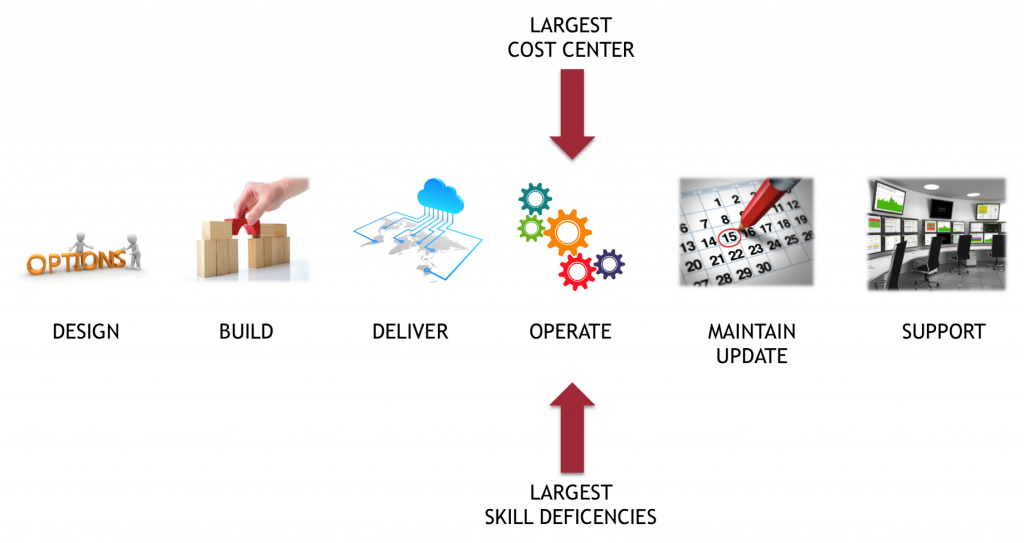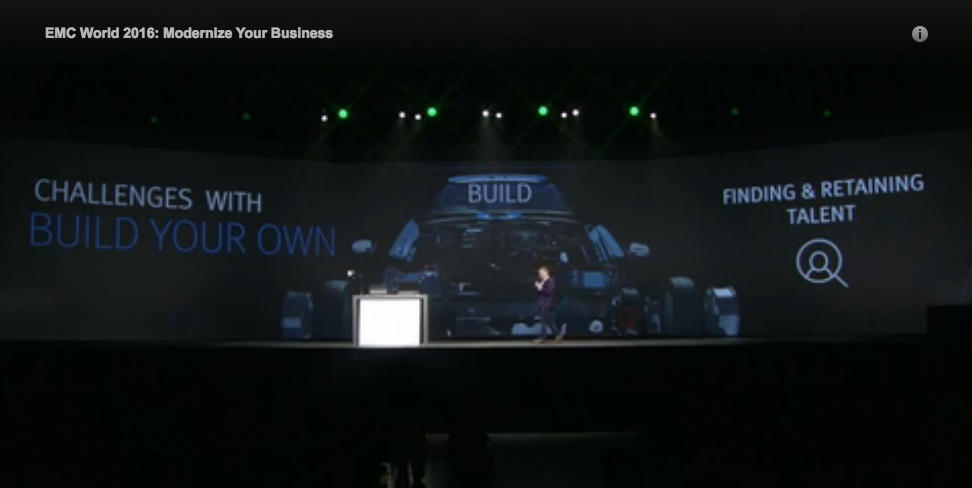Premise: Building and operating a cloud computing environment is extremely complicated, as showcased by the low numbers of True Private Cloud environments in production compared to public cloud usage. Wikibon’s projections show that over $300B is spent just operating IT environments, of which $150B can be reduced by vendors and cloud computing providers embedded operational capabilities within their offerings.
The consensus amongst many CIOs is that the future of IT will be a Hybrid Cloud world, with workloads (both new and old) running in a combination of on-premises and public cloud environments. In order to avoid the existing problem where on-premises environments are operated much differently than public clouds, new solutions are being brought to market in ways that help alleviate the lack of operational expertise on-premises. Vendor-led examples of this include Cisco MetaCloud, IBM Bluemix Local, Oracle Cloud Machine, Platform 9, and ZeroStack. Cloud-provider examples of this include Expedient Private and Hybrid Cloud, and Rackspace Managed OpenStack.

Does the “Turnkey” aspect of EMC’s Native Hybrid Cloud go far enough?
This past week at EMC World 2016, EMC announced their Native Hybrid Cloud solution. This offering expands upon EMC’s experience from the Federation Enterprise Hybrid Cloud offering to focus on cloud-native applications. The solution comes from EMC’s Solution Group, and builds upon the VCE Vblock expertise within the Converged Platform Division. Within the technology stack, the solution brings together Pivotal Cloud Foundry, EMC’s distribution of OpenStack (from the Cloudscaling acquisition) and VxRack 1000 converged infrastructure running EMC’s ScaleIO storage. In the future, the OpenStack layer can optionally be replaced with VMware’s container-centric Photon platform. The IaaS and converged infrastructure layers are part of a new offering called Neutrino Nodes. All aspects of the solution are glued together through a set of internally developed, container-based management and provisioning technologies.
VIDEO: Drew Dimmick (@drewdimmick, Product Management Lead at EMC) and James Watters (@wattersjames, SVP Product at Pivotal) discuss the new Native Hybrid Cloud solution from EMC.
In the past, EMC has been successful in delivering converged infrastructure solutions through their VCE division, primarily through the Vblock family of products. The ability of VCE to Design, Build, Ship and Maintain the Vblock system has been a key to their market leadership in converged infrastructure, with a unique set of processes that are helping move EMC towards simpler to consume offerings in the market. EMC calls this approach “Build vs. Buy”, where “Build” is a DIY approach to hardware+software and “Buy” is an engineered Vblock or VxRack / VxRail offering.
The new Native Hybrid Cloud solution is described in more detail on Chad Sakac’s Virtual Geek blog (@sakacc; President, EMC Converged Platform Division). In the blog, Sakac highlights the key lifecycle aspects of the new solution.

Missing from this list is one very critical element – Operations.
In the past, EMC and VCE solutions were built on well understood technologies, such as VMware vSphere. In addition, they were primarily designed for environments where the pace of change aligned to “Platform 2” applications, which often had release/update cycles that were once a year. While these environments had some levels of change, they are typically not the rapidly changing environments associated with DevOps, Continuous Delivery and cloud-native applications. The operational model of these traditional environments was relatively well understood and the skills needs to run operations was established in the market.
Will Cloud Native platforms be Shelf-ware without the Right Skills?
During his keynote address on Day 3 of EMC World, Sakac highlighted that cloud-native skills were extremely difficult to hire and retain. The 2016 Open Source Jobs Report highlights that 87% of companies are struggling to find talent for emerging open source technologies. Searches from popular technical job site Dice.com shows many openings for engineers with OpenStack and Cloud Foundry skills.

By no means is this lack of skills and experience unique to EMC’s solution or customers. But not actively helping customers accelerate their operational learning curve does create the potential to significantly impact the success of the EMC solution. This lack of operational skills is at the core of trends such as “Shadow IT” and a strong reason why many Enterprise developers are selecting public cloud offerings from Amazon AWS and Microsoft Azure.
NOTE: Replicating a public cloud operational model is difficult with on-premises solutions, even if the same technology is used in both locations. Another example of this is Microsoft’s Azure Stack, which uses much of the same software that is used in Microsoft Azure (public cloud), but it must be managed on-premises by the customers. Finding engineers that have Azure operational skills will be as difficult to find as engineers with OpenStack or Cloud Foundry skills, if not more so because the Azure software is not freely available via open source today.
Can EMC address the Operations Opportunity?
As mentioned earlier, several vendors are beginning to address this challenge by embedded cloud-native operations within their solution. While these offerings are still in the early stages, they allow customers to focus their activities above the “value line”, developing new applications.
Prior to the launch of the Native Hybrid Cloud solution, Pivotal addressed this challenge by operating Pivotal Web Services (PWS). PWS delivered a public cloud version of Pivotal Cloud Foundry (PCF) that was operated by Pivotal engineers, and delivered as an on-demand service to customers. This allows Pivotal Cloud Foundry customers to begin developing application immediately, while waiting for internal Pivotal Cloud Foundry environments to be built. It did not provide operations for the on-premises PCF.
EMC may be able to deliver a managed on-premises offering of Native Hybrid Cloud using their managed services capabilities, but this is currently not available. Wikibon discussed this with Virtustream’s CEO Rodney Rogers, who is responsible for EMC’s cloud managed services offerings.
VIDEO: Rodney Rogers (@rjrogers87 – CEO, Virtustream – An EMC Company) discusses the managed services capabilities of EMC and Virtustream.
Action Item: The customer experience for cloud-native application is being defined by the public cloud providers and public cloud services. Customer skills are slowly evolving, but they still struggle to develop the skills necessary to build and operate on-premises cloud environments. Vendors and cloud providers must step up to the $150B opportunity to help their customers accelerate their learning curve. EMC should be proactive in articulating a roadmap to deliver managed versions of the Native Hybrid Cloud solution to accelerate their customer’s ability to focus on building cloud-native applications and evolving digital business strategies.
Without focusing on the critical aspects of operations, many vendor-driven offerings will fail to meet customer expectations, accelerating the already rapid growth of public cloud services. Customers should seriously consider delaying consideration of these types of solutions unless the vendors or cloud providers can articulate a clear offering or roadmap for delivering capabilities that will augment operations and help make developer-centric platforms successful.

